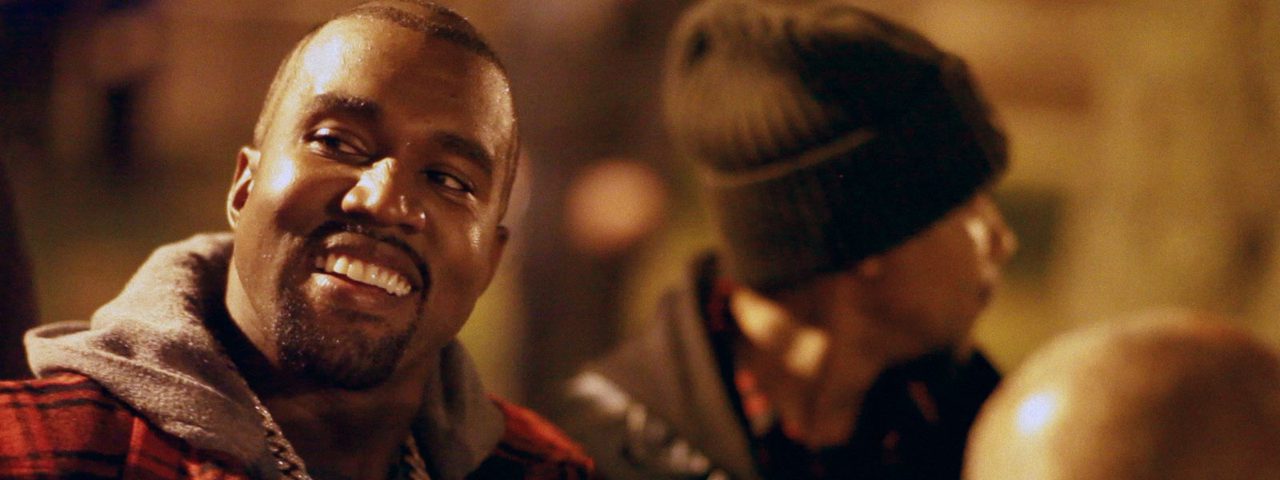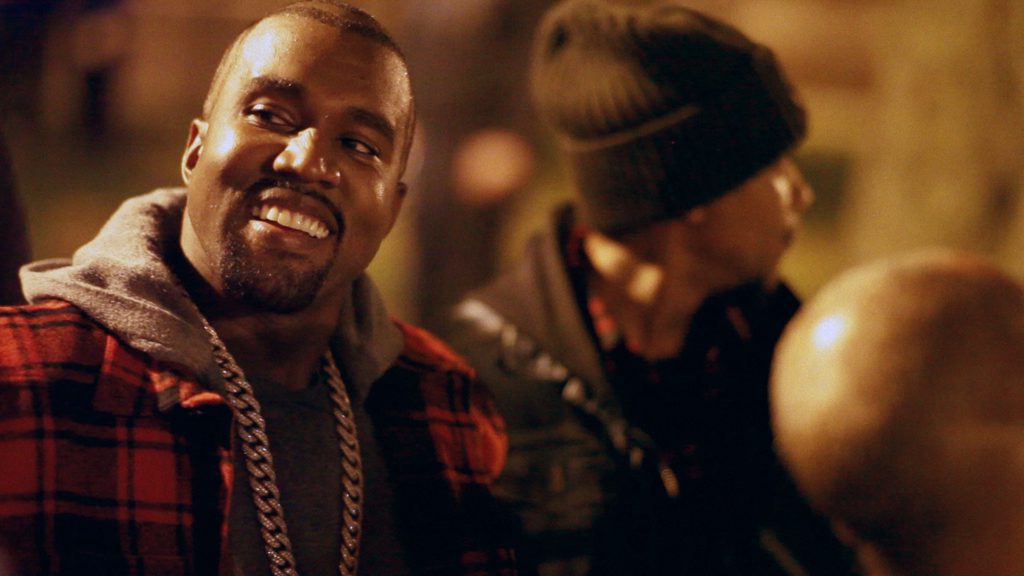jeen-yuhs: A Kanye Trilogy - Review
A scattered portrait of a contentious figure.

Part one of jeen-yuhs: A Kanye Trilogy debuts on Netflix on Feb. 16, with parts two and three hitting the streaming service on Feb. 23 and March 2, respectively. The below review covers all three parts as a whole.
With Kanye West’s 11th album set for release in February, during the rollout of Netflix’s three-part documentary jeen-yuhs: A Kanye Trilogy, it seemed inevitable that the rapper would launch his next social media tirade (the targets this time were Kid Cudi, Pete Davidson, and Billie Eilish, and the medium was poorly Photoshopped memes). Some would call it a publicity stunt, but the film series offers a look behind the scenes, exploring — among other things — the way West responds to pressure and often cracks under its weight. The problem, however, is that the trilogy’s total runtime clocks in at four and a half hours and the result is often deeply unfocused. On one hand, this is a byproduct of the film pulling from over 20 years of footage. On the other, its directors’ proximity to their subject only allows them to dig so deep.
Each film runs about 90 minutes and is set for weekly release starting Feb. 16. The first entry, titled “act i: VISION,” opens with a teaser for what’s to come by introducing us to the Kanye West of 2020, a portrait of failed political ambitions and paranoid military vests. A peek behind the curtain of this version of West is an intriguing prospect, given his many public spectacles of late. However, this “new Kanye,” with his sunken eyes, doesn’t reappear until well into the third chapter, after about four hours’ worth of runtime that plays less like a single story and more like a comprehensive retelling of West’s adult life, for better and for worse.
What follows is not altogether uninteresting, though it has a tendency to feel unwieldy. The first part explores West’s career as a producer until his famous 2002 car accident, while the second details the success he later found as a rapper. However, there’s an odd and almost logistical sense of proportionality to the footage employed. Directors Coodie & Chike (Coodie in particular) began filming West before he was a household name, but once he found fame, they documented his life less and less as the years went by. The first film, as well as the second (“act ii: PURPOSE”), therefore go into an undiscerning amount of detail, while the third (“act iii: AWAKENING”) collapses nearly two decades’ worth of footage into its runtime. From a structural standpoint, this imbalance leaves the first two chapters feeling excessive, as if not enough time had been spent actually carving out a distinct narrative. The third part is where the meat of the story lies — where everything that was painstakingly set up by the first two chapters comes to stunning (and occasionally disturbing) fruition. However, the length of buildup is likely to ensure that some viewers will throw in the towel along the way.
Then again, a shorter and more disciplined version would probably not feel as intimate as jeen-yuhs sometimes does. A double-edged sword by nature, the series is as much about West as an individual as it is about Coodie’s relationship to him; editors Max Allman and J.M. Harper can only be faulted so much for scenes that feel like they last a lifetime, since these segments are as much about West’s musical processes they are about Coodie observing him over the years, watching him grow. Coodie, the Channel Zero host and eventual music video director, first saw something in West back in 1998, before he was a super-producer for heavy hitters like Jay-Z. Each film touches on (and is bookended by) a look at how Coodie and West’s lives paralleled one another, and the ways they diverged and crossed paths over the years. While this is one of the series’ more alluring ideas, it’s often sidetracked in favor of extended “scenes” of West playing his music for other people during his earlier years, when he was trying to break through as an emcee.
These scenes can be interesting too, provided you’re already a fan of West and care about his music. Coodie & Chike present his innovative talents as a given, leaving room for them to take a unique approach to his artistry, rather than spending time trying to convince you of his abilities (in this way, jeen-yuhs perfectly reflects West’s egotistical self-image; anyone in the film who doubts him is framed as being wrong). The filmmakers separate West’s vocal tracks from his beats, presenting awkward acapella performances that eventually morph into something incredible when his melodies are slowly reintroduced. This approach runs parallel to the story of West’s early years, where most people saw him as a producer but he insisted on being seen as a vocalist first and foremost. In separating these two sides of West before combining them in dazzling fashion, Coodie & Chike seem to offer their own opinion on his two creative halves and how well they work in tandem.
These scenes, of West attempting to convince people of his poetic talents, also play like prototypes for his modern “listening party” release strategy at lavish locations, only they’re steeped in the struggle of a young artist trying to pitch himself, rather than in the self-serving ego of a successful celebrity. Once again, the idea which the film most effectively puts forth through its personal exposé, is that these two halves of West — which may be viewed differently by the public — are sides of the same coin. Over the years, the filmmakers are granted access to West’s private life, including moments with his mother, Donda West, an incredibly sweet and motivating presence. By presenting her passionate support for her son, the series captures yet another prototype of sorts in the form of his glowing self-confidence, which would eventually morph into his now-notorious arrogance. Coodie narrates the entire film with a sense of sincerity, and while he may not comment explicitly on this evolution, merely presenting these two sides of West (before and after his mother’s death) is enough to draw the connections between them.
It's too unwieldy and undisciplined for its most effective moments to last.
Similarly, the filmmakers spend a noticeable chunk of “act i” focusing on West’s fixation with his appearance — specifically his mouth and his adult retainers — details that would have been left on the cutting room floor in most other music documentaries. However, given the accident that would eventually disfigure West’s face (and would in turn lead to his hit single “Through the Wire,” which he rapped with his jaw wired shut), they leave these moments in the edit, allowing them to play out as silent beats of poetic irony. Coodie wouldn’t dare make an explicit statement about his friend’s appearance or his issues of self-esteem (let alone his abominable fashion endeavors, which come up at a surprising moment), but these ideas hover constantly in the background.
This tension, between Coodie the filmmaker and Coodie the confidant, is yet another thread that jeen-yuhs hints at numerous times, but it’s often brushed aside in favor of a more straightforward story about the linear rise (and fall) of Kanye West. However, the moments in which this idea is finally expressed, often indirectly, are some of the film’s aesthetic highlights, taking the form of raw, glitchy montages that powerfully combine past and present, as if Coodie & Chike know exactly which of West’s controversial moments they would discuss at length if they didn’t consider him a brother. The downside to this approach is that when it comes time to finally dig into those details — mostly in “act iii” — the extent of their exploration is Coodie telling us he wants to better understand West in his worst and most publicly vulnerable moments. A noble cause, but saying it and actually doing it are two different things, and Coodie rarely uses his camera to investigate what troubles West, and why his antics take the form they do. Ironically, the film fails to express something central and fundamental to an artist who fails to express things precisely in public, resulting in his numerous faux pas.
Equally ironic is the fact that the most emotionally charged moments in “act iii” are not a result of what Coodie chooses to film, but what he chooses not to. West’s mental health struggles are well-documented, and Coodie occasionally decides to cut the camera during his friend’s most vulnerable moments rather than continuing to shoot. It’s an inversion of the traditional documentarian instinct to try and capture every moment, and it results in a deeply personal portrait of the series’ central relationship.
The problem, however, is that during its pursuit of something uniquely intimate, jeen-yuhs: A Kanye Trilogy rarely reaches this level of poignancy while the cameras are rolling.
The Verdict
During its combined 4.5 hour runtime, jeen-yuhs: A Kanye Trilogy introduces a number of charged and interesting ideas, but it rarely finds consistent focus. It tries to create an intimate behind-the-scenes look at a great artist with a notorious public image, and while it succeeds on occasion, it’s too unwieldy and undisciplined for its most effective moments to last.
jeen-yuhs: A Kanye Trilogy Review

